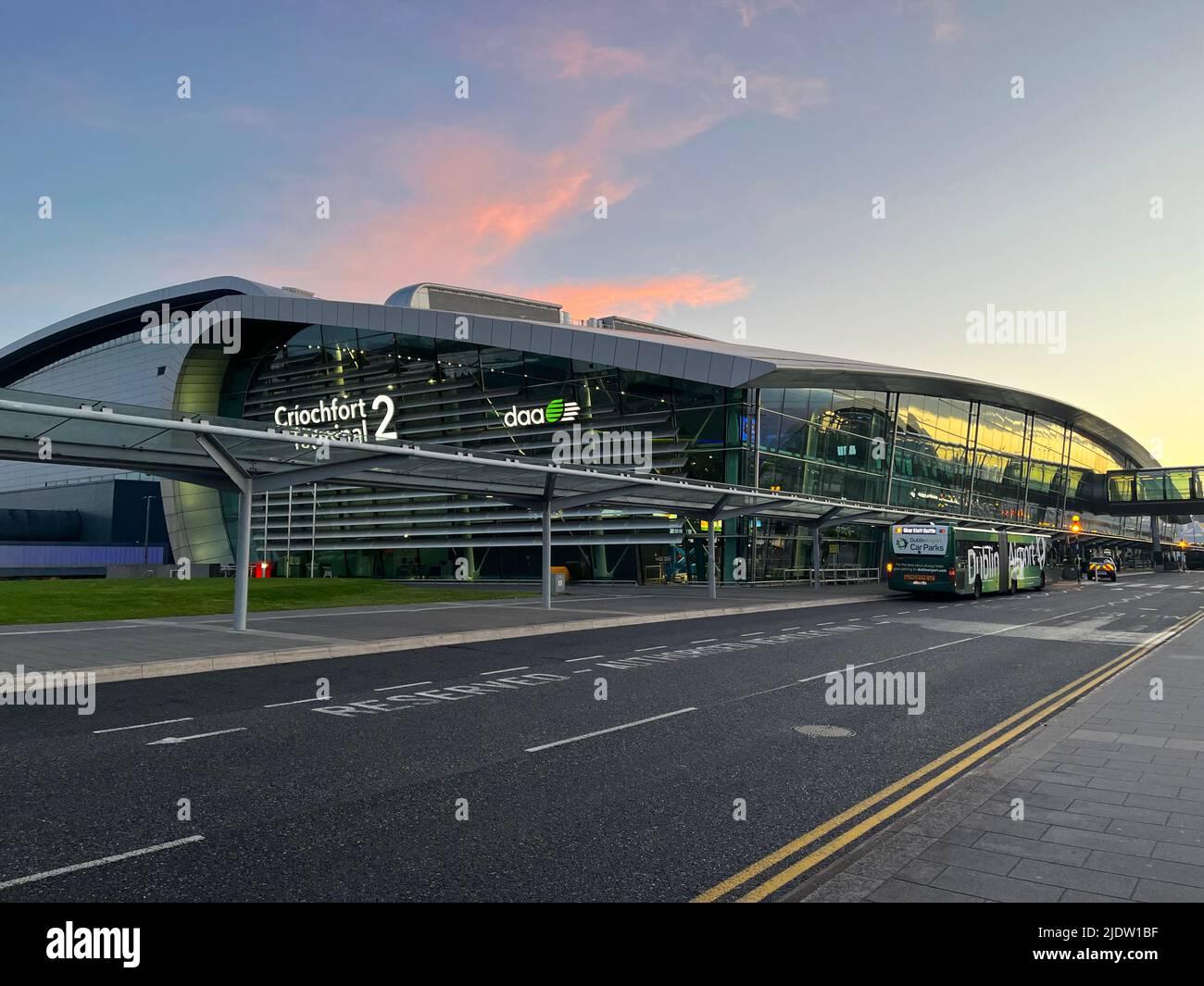
Dublin Airport’s Terminal 2 experienced a temporary disruption recently due to a security alert. Following a thorough investigation, authorities have given the all-clear, and normal operations have resumed. This incident caused some delays and inconvenience for passengers, but airport staff worked diligently to ensure safety and minimize disruption.
The swift response and efficient handling of the situation highlight the airport’s commitment to security protocols. Passengers are now able to proceed with their travel plans, with flights returning to their scheduled times.
Details of the Security Alert at Dublin Airport
Initial Incident and Response
The security alert was triggered by concerns regarding a piece of luggage. As a precautionary measure, Terminal 2 was temporarily evacuated to allow for a full security sweep. Emergency services, including the bomb squad, were dispatched to the scene to assess the situation. The safety of passengers and staff remained the top priority throughout the process.
According to reports, the incident began when airport security identified a bag of interest. Standard protocols were immediately activated, leading to the evacuation. The Dublin Airport Authority worked in close coordination with An Garda Síochána (Irish police) to manage the situation effectively. The airport implemented its emergency plan to ensure an orderly evacuation and to provide assistance to affected passengers.
Investigation and All-Clear
Following a comprehensive examination by the bomb squad and security personnel, the suspicious baggage was deemed safe. No hazardous materials or threats were found. This allowed authorities to give the all-clear, and Terminal 2 was reopened to the public. The investigation involved a detailed analysis of the contents of the bag and a review of security footage to determine the origin and intent behind the potentially suspicious item.
The airport confirmed the reopening of Terminal 2 via social media, assuring passengers that normal operations were resuming. They thanked passengers for their cooperation and understanding during the disruption. The quick resolution of the incident was attributed to the vigilance of security staff and the effectiveness of the airport’s security protocols.
Impact on Flights and Passengers
The temporary closure of Terminal 2 resulted in flight delays and some cancellations. Passengers were advised to check with their airlines for the latest updates on their flight schedules. Many travelers experienced frustration and anxiety due to the uncertainty surrounding the situation. Airport staff were on hand to provide information and assistance to those affected, helping them to rebook flights and find alternative accommodations where necessary.
Airlines operating from Terminal 2 worked to minimize the impact on their passengers. Extra staff were deployed to assist with rebooking and to provide customer service. The airport also provided updates through its website and social media channels, keeping passengers informed about the progress of the security investigation and the resumption of normal operations. While the disruption was significant, the swift response helped to mitigate the long-term effects on travel schedules.
Reactions and Aftermath
Passenger Experiences and Testimonials
Many passengers took to social media to share their experiences during the evacuation. Some praised the airport staff for their professionalism and efficiency in handling the situation, while others expressed concern about the delays and inconvenience caused. The overall sentiment was one of relief that the incident was resolved safely and without any harm to passengers or staff.
One passenger recounted the experience, stating, “The evacuation was handled very calmly and efficiently. Airport staff were very helpful in directing people and providing information.” Another passenger noted, “While the delay was frustrating, I appreciate the airport taking the necessary precautions to ensure our safety.” These testimonials highlight the importance of clear communication and effective crowd management during emergency situations.
Official Statements and Airport Authority Response
The Dublin Airport Authority issued a statement acknowledging the incident and thanking passengers for their cooperation. They reiterated their commitment to maintaining the highest standards of security and safety at the airport. The statement also commended the airport staff and emergency services for their swift and professional response.
According to a spokesperson for the airport, “The safety and security of our passengers and staff are always our top priority. We take all security alerts seriously and follow established protocols to ensure the safety of everyone at the airport.” The airport authority also emphasized the importance of ongoing training and vigilance in maintaining a secure environment for air travel.
Lessons Learned and Future Security Measures
Following the incident, Dublin Airport is likely to review its security protocols and procedures to identify any areas for improvement. This may include enhanced screening measures, increased security personnel, and improved communication systems. The goal is to ensure that the airport is well-prepared to respond to any future security threats and to minimize disruption to passengers.
Security experts suggest that airports around the world are constantly adapting their security measures to address evolving threats. This includes investing in advanced technology, such as biometric screening and artificial intelligence, to detect potential risks more effectively. Collaboration between airports, law enforcement agencies, and intelligence services is also crucial in maintaining a secure aviation environment. Related coverage on airport security protocols can offer further insights.
Broader Context of Airport Security
Global Security Concerns and Airport Vulnerabilities
Airports are recognized as potential targets for terrorist attacks and other security threats. The high concentration of people, the international nature of air travel, and the symbolic importance of airports make them attractive targets. As a result, airports around the world have implemented stringent security measures to protect passengers and prevent attacks.
These measures include enhanced screening of passengers and luggage, increased surveillance, and the deployment of security personnel. However, airports also face challenges in balancing security with the need to maintain efficient operations and minimize inconvenience to passengers. The challenge is to create a security environment that is both effective and unobtrusive.
The Role of Technology in Enhancing Security
Technology plays a crucial role in enhancing airport security. Advanced screening technologies, such as body scanners and explosive detection systems, can help to identify potential threats more quickly and accurately. Biometric identification systems can verify the identity of passengers and prevent unauthorized access to secure areas. Data analytics and artificial intelligence can be used to identify patterns and anomalies that may indicate suspicious activity.
However, technology is not a panacea. It is important to ensure that security technologies are used effectively and that security personnel are properly trained to interpret the results. There is also a need to address privacy concerns associated with the use of advanced screening technologies. The key is to strike a balance between security and privacy.
Balancing Security with Passenger Convenience
One of the biggest challenges for airports is to balance security with the need to provide a convenient and efficient travel experience for passengers. Long security lines, intrusive screening procedures, and strict baggage restrictions can be frustrating for travelers. However, these measures are necessary to ensure the safety of air travel.
Airports are exploring various ways to improve the passenger experience while maintaining high levels of security. This includes implementing expedited screening programs, such as TSA PreCheck, which allow pre-approved travelers to bypass some security procedures. The use of technology to streamline the screening process can also help to reduce waiting times and improve the overall passenger experience.
A general view of Dublin Airport Terminal 2, after the security alert was cleared and normal operations resumed.
The Impact of False Alarms
Psychological Effects on Passengers and Staff
Even when a security alert turns out to be a false alarm, it can still have a significant psychological impact on passengers and staff. The sudden evacuation, the uncertainty about the nature of the threat, and the disruption to travel plans can cause anxiety and stress. It is important for airports to provide support and counseling to those affected by such incidents.
For staff, dealing with security alerts can be particularly challenging. They are responsible for implementing emergency procedures, managing crowds, and providing information to passengers. The pressure of these responsibilities can take a toll, especially when dealing with false alarms. Airports should provide training and support to help staff cope with the stress of these situations.
Economic Costs and Operational Disruptions
False alarms can also have significant economic costs. The closure of a terminal can result in flight delays, cancellations, and lost revenue for airlines and airport businesses. The cost of deploying emergency services and conducting security investigations can also be substantial.
In addition to the direct economic costs, there are also indirect costs associated with the disruption to travel plans. Passengers may miss connecting flights, business meetings, or other important events. The overall impact on the economy can be significant. It is important for airports to minimize the frequency of false alarms by improving security procedures and investing in advanced technology.
Strategies for Minimizing False Alarms
There are several strategies that airports can use to minimize the frequency of false alarms. This includes improving the accuracy of screening technologies, providing better training to security personnel, and enhancing communication with passengers. It is also important to have clear protocols for responding to security alerts and to ensure that these protocols are followed consistently.
Another strategy is to engage with the public to raise awareness about security procedures and to encourage passengers to report any suspicious activity. By working together, airports and passengers can help to create a safer and more secure travel environment. Airports are also exploring the use of behavioral analysis techniques to identify potential threats before they materialize.
Key Takeaways:
- Dublin Airport’s Terminal 2 was temporarily evacuated due to a security alert.
- The alert was triggered by concerns regarding a piece of luggage.
- Following a thorough investigation, authorities gave the all-clear.
- Normal operations have resumed, and passengers can proceed with their travel plans.
- The incident highlights the importance of vigilance and effective security protocols.
FAQ:
What caused the security alert at Dublin Airport Terminal 2?
The security alert was triggered by concerns regarding a piece of luggage that was flagged during routine screening.
How long was Terminal 2 closed?
Terminal 2 was temporarily closed for a few hours while authorities conducted a thorough security sweep.
Are flights operating on schedule now?
Yes, normal operations have resumed, and flights are returning to their scheduled times. Passengers should check with their airlines for the latest updates.
What should I do if I have concerns about security at the airport?
If you have any concerns about security, you should immediately report them to airport staff or security personnel. Your vigilance can help to ensure the safety of everyone at the airport.
Will Dublin Airport compensate passengers for delays?
Compensation for delays depends on the airline’s policy and the specific circumstances. Passengers should contact their airline directly to inquire about compensation.
What measures are in place to prevent future security alerts?
Dublin Airport continuously reviews and enhances its security protocols, invests in advanced technology, and provides ongoing training to security personnel to prevent future incidents.
In conclusion, the recent security alert at Dublin Airport’s Terminal 2, which led to the terminal being given the ‘all-clear’ after a brief evacuation, serves as a reminder of the constant vigilance required to maintain safety in air travel. While the incident caused temporary disruptions, the swift and effective response by airport staff and security personnel ensured that the situation was resolved quickly and without harm to passengers. As Dublin Airport continues to prioritize security measures and adapt to evolving threats, passengers can remain confident in the airport’s commitment to providing a safe and secure travel environment. For more information on Dublin Airport’s security procedures, visit the airport’s official website.

